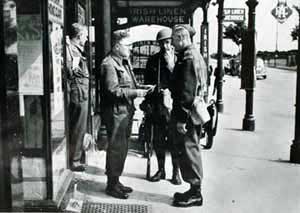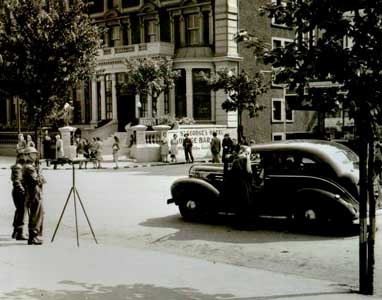Former Home Guard HQ, Llandudno
![]() Former Home Guard HQ, St George’s Place
Former Home Guard HQ, St George’s Place
 This building’s ground floor was formerly Irish Linen Warehouse’s premsies. The first floor was a ballroom, used as an army canteen in the Second World War. Meanwhile the Home Guard used the building as its base, particularly for major exercises, and installed a pigeon loft here. If other communications failed, homing pigeons would be used to carry messages. The photo (right) shows Home Guard members outside their HQ.
This building’s ground floor was formerly Irish Linen Warehouse’s premsies. The first floor was a ballroom, used as an army canteen in the Second World War. Meanwhile the Home Guard used the building as its base, particularly for major exercises, and installed a pigeon loft here. If other communications failed, homing pigeons would be used to carry messages. The photo (right) shows Home Guard members outside their HQ.
Today the ground floor hosts the RNLI charity’s shop, raising funds for Llandudno lifeboat.
The Home Guard is an object of fun in the TV comedy Dad’s Army, but it was important to domestic security during the war. On 14 May 1940 the Minister of War, Anthony Eden, announced on the wireless the formation of the Local Defence Volunteers. Winston Churchill changed the name to Home Guard in August 1940. This was when the risk of Germany invading Britain was at its highest. The Home Guard was for men who were too young or too old to join the regular army or worked in reserved occupations (jobs that were important to the war effort).
Llandudno men registered at the town’s police station. Jack Owen, a Crosville bus driver, was first to enrol – minutes after the broadcast. A week later, 414 local men had volunteered, including 100 Inland Revenue civil  servants. On the evening of 31 May 1940, the volunteers gathered at the Town Hall for their first parade and night patrols.
servants. On the evening of 31 May 1940, the volunteers gathered at the Town Hall for their first parade and night patrols.
There were four Home Guard companies: ‘A’ Company patrolled the Great Orme; ‘B’ West Shore; ‘C’ Craig-y-Don; and ‘D’ Penrhynside. Lt-Col WH Lester took command of the 5th Battalion (Caernarvonshire) Home Guard, headquartered at the Irish Linen Warehouse. The photo (left) shows the Home Guard training in St George’S Place.
At Maesdu Farm, south-west of Llandudno, the battalion built an assault course and a range for rifle and machine-gun practice. Home Guard patrols scoured the town for “enemy” combatants and stopped motorists at roadblocks, where identity cards were checked. The “enemy” for training purposes were soldiers from the Royal Corps of Signals. Those caught were taken to the Town Hall for interrogation.
The Home Guard were a familiar sight in Llandudno during the war, taking part in parades and holding social gatherings centred on a “hot pot” dinner and entertainment by men of the battalion.
With thanks to Adrian Hughes, of the Home Front museum
Postcode: LL30 2NR
Other MILITARY HiPoints in this area:
Airship repair site 1918 – police urged the crowd of onlookers not to smoke
Drill Hall - read about the link with the Wormhout massacre
Former US Army officers' and doctors' mess
Lloyd George salute site – see a photo of the wartime premier watching troops on Llandudno prom

